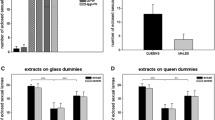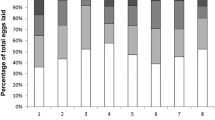Summary
Both field observations and laboratory experiments have suggested that queens of I. humilis inhibit the production of new queens (gynes). Using small colony fragments, laboratory experiments were conducted to determine the means by which this inhibition is achieved. The addition of queen corpses to queenless fragments effectively inhibited the production of gynes, suggesting that a queen inhibitory primer pheromone is involved. This inhibitory influence was removed when corpses were washed in pentane, lending further support to the pheromonal hypothesis. Adult gynes (winged virgin queens) were not inhibitory, whereas young dealated mated queens of the same age were, suggesting that only inseminated queens produce the pheromone. Daily addition of eggs to queenless units did not appear to have a strong inhibitory influence, indicating that the lower worker/larva ratios associated with the presence of an egg-laying queen in such colony fragments does not greatly influence the production of sexuals. Pheromonal inhibition of gyne development appears to be achieved mainly by preventing the sexualization of bipotent female larvae, probably by affecting the brood-rearing behavior of workers. In addition, queens may also cause the execution of female larvae after they have become sexualized. In nearly all cases, the addition of a living queen to previously queenless units containing gyne larvae caused workers to execute one or more of these larvae within 24 h. In some cases queens were also seen attacking gyne larvae. The addition of queen corpses resulted in the execution of gyne larvae, suggesting that a queen pheromone mediates, at least in part, this execution behavior of workers. These results show that I. humilis queens exert control over the production of gynes in two ways: (1) by preventing the sexualization of female larvae and (2) by killing female larvae after they have become sexualized. A queen primer pheromone appears to be involved in both processes. Queen behavior also plays a role, at least in the execution of gyne larvae. This queen control over the production of gynes, probably mostly pheromonal, appears to operate strongly in the field where gynes are produced only in spring just after a sharp drop in the inhibitory queen influence due to the massive execution of queens by the workers.
Similar content being viewed by others
References
Barbier M, Lederer E (1960) Structure chimique de la substance royale de la reine d'abeille (Apis mellifica L.). CR Acad Sci Paris, série D 250:4467–4469
Bartels PJ (1983) Polygyny and reproductive biology of the Argentine ant. PhD dissertation, University of California, Santa Cruz
Bartels PJ (1988) Reproductive caste inhibition by Argentine ant queens: new mechanisms of queen control. Insectes Soc 35:70–81
Benois A (1973) Incidence des facteurs écologiques sur le cycle annuel et l'activité saisonnière de la fourmi d'Argentine, Iridomyrmex humilis Mayr dans la région d'Antibes. Insectes Soc 20:267–296
Bourke AFG (1988) Worker reproduction in the higher eusocial Hymenoptera. Q Rev Biol 63:291–311
Brian MV (1970) Communication between queens and larvae in the ant Myrmica. Anim Behav 18:467–472
Brian MV (1973) Caste control through worker attack in the ant Myrmica. Insectes Soc 20:87–102
Brian MV (1980) Social control over sex and caste in bees, wasps and ants. Biol Rev 55:379–415
Brian MV, Blum MS (1969) The influence of Myrmica queen head extracts on larval growth. J Insect Physiol 15:2213–2223
Brian MV, Hibble J (1963) 9 oxodec-trans-2-enoic acid and Myrmica queen extracts tested for influence on brood in Myrmica. J Insect Physiol 9:25–34
Butler CG, Callow RK, Johnston NC (1961) The isolation and synthesis of queen substance, 9-oxodec-trans-2-enoic acid, a honeybee pheromone. Proc R Soc London Ser B 155:417–432
Carr CAH (1962) Further studies on the influence of the queen in ants of the genus Myrmica. Insects Soc 9:197–211
Dejean A, Passera L (1974) Ponte des ouvriéres et inhibition royale chez la fourmi Temnothorax recedens (Nyl). Insectes Soc 21:343–356
Edwards JP (1987) Caste regulation in the Pharaoh's ant Monomorium pharaonis: the influence of queens on the production of new sexual forms. Physiol Entomol 12:31–39
Fletcher DJC, Blum MS (1981 a) Pheromonal queen control of dealation and oogenesis in virgin queen fire ants. Science 212:73–75
Fletcher DJC, Blum MS (1981 b) A bioassay technique for an inhibitory primer pheromone of the ant, Solenopsis invicta Buren. J Ga Entomol Soc 16:352–356
Fletcher DJC, Blum MS (1983) Regulation of queen number by workers in colonies of social insects. Science 219:312–314
Fletcher DJC, Ross KG (1985) Regulation of reproduction in eusocial Hymenoptera. Annu Rev Entomol 30:319–343
Free JB (1987) Pheromones of social bees. Chapman & Hall, London
Giraud L (1983) Role inhibiteur du facteur ≪groupement de reines≫ sur l'apparition des males chez Iridomyrmex humilis, Hymenoptera, Dolichoderinae. CR Acad Sci Paris Sér III 296:655–658
Hölldobler B, Bartz SH (1985) Sociobiology of reproduction in ants. In: Hölldobler B, Lindauer M (eds) Experimental behavioral ecology and sociobiology. Sinauer Associates, Sunderland, MA, pp 237–257
Hölldobler B, Carlin NF (1985) Colony founding, queen dominance and oligogyny in the Australian meat ant Iridomyrmex purpureus. Behav Ecol Sociobiol 18:45–58
Hölldobler B, Wilson EO (1983) Queen control in colonies of weaver ants (Hymenoptera: Formicidae). Ann Entomol Soc Am 76:235–238
Hölldobler B, Wilson EO (1990) The ants. Harvard University Press, Cambridge
Keller L (1988) Evolutionary implications of polygyny in the Argentine ant, Iridomyrmex humilis (Mayr) (Hymenoptera: Formicidae): an experimental study. Anim Behav 27:839–844
Keller L, Passera L, Suzzoni J-P (1989 a) Queen execution in the Argentine ant, Iridomyrmex humilis. Physiol Entomol 14:157–163
Keller L, Cherix D, Ulloa-Chacon P (1989 b) Description of a new artificial diet for rearing ant colonies as Iridomyrmex humilis, Monomorium pharaonis and Wasmannia auropunctata (Hymenoptera, Formicidae). Insectes Soc 36:348–352
Markin GP (1970) The seasonal life cycle of the Argentine ant, Iridomyrmex humilis (Hymenoptera: Formicidae), in southern California. Ann Entomol Soc Am 63:1238–1242
Masuko K (1986) Larval hemolymph feeding: a nondestructive parental cannibalism in the primitive ant Amhlyopone silvestrii Wheeler (Hymenoptera: Formicidae). Behav Ecol Sociobiol 19:249–255
Oster GF, Wilson EO (1978) Caste and ecology in the social insects. Princeton University Press, Princeton
Passera L (1969) Biologic de la reproduction chez Plagiolepis pygmaea Latreille et ses deux parasites sociaux Plagiolepis grassei Le Mastic et Passera et Plagiolepis xene Stärcke (Hymenoptera, Formicidae). Ann Sci Nat Zool Paris 12eme série 11:327–482
Passera L (1980) La fonction inhibitrice des reines de la fourmi Plagiolepis pygmaea Latr: rôle des phéromones. Insectes Soc 27:212–225
Passera L, Keller L, Suzzoni J-P (1988a) Control of brood male production in the Argentine ant Iridomyrmex humilis (Mayr). Insectes Soc 35:19–33
Passera L, Keller L, Suzzoni J-P (1988b) Queen replacement in dequeened colonies of the Argentine ant Iridomyrmex humilis (Mayr). Psyche 95:59–65
Torossian C (1968) Recherches sur la biologic et l'éthologie de Dolichoderus quadripunctatus (L.) (Hym. Form. Dolichoderidae). VII. Etude des méchanismes permettant l'inhibition de la ponte des ouvrières en présence de leur reine: rôle des phéromones. Insectes Soc 15:105–144
Trivers RL, Hare H (1976) Haplodiploidy and the evolution of the social insects. Science 191:249–263
Vander Meer RK (1983) Semiochemicals and the red imported fire ant (Solenopsis invicta Buren) (Hymenoptera: Formicidae). Fla Entomol 66:139–161
Vargo EL (1986) Queen control over the production of sexuals in the fire ant, Solenopsis invicta. PhD dissertation, University of Georgia
Vargo EL (1988) A bioassay for a primer pheromone of queen fire ants (Solenopsis invicta) which inhibits the production of sexuals. Insectes Soc 35:382–392
Vargo EL (1990) Social control of reproduction in fire ant colonies. In: Vander Meer RK, Jaffe K, Cedeno A (eds) Applied myrmecology: a world perspective. Westview Press, Boulder, CO, pp 158–172
Vargo EL, Fletcher DJC (1986) Evidence of pheromonal queen control over the production of male and female sexuals in the fire ant, Solenopsis invicta. J Comp Physiol A 159:741–749
Vargo EL, Fletcher DJC (1987) Effect of queen number on the production of sexuals in natural populations of the fire ant, Solenopsis invicta. Physiol Entomol 12:109–116
West Eberhard MJ (1977) The establishment of reproductive dominance in social wasp colonies. Proc VIIIth Int Congress, IUSSI, Wageningen, 5–10 Sept, pp 223–227
West Eberhard MJ (1978) Temporary queens in Metapolyhia wasps: nonreproductive helpers without altruism? Science 200:441–443
West Eberhard MJ (1981) Intragroup selection and the evolution of insect societies. In: Alexander RD, Tinkle DW (eds) Natural selection and social behavior: recent research and new theory. Chiron, New York, pp 3–17
Wheeler DE (1986) Developmental and physiological determinants of caste in social Hymenoptera: evolutionary implications. Am Nat 128:13–34
Willer DE, Fletcher DJC (1986) Differences in inhibitory capability among queens of the ant Solenopsis invicta. Physiol Entomol 11:475–482
Wilson EO (1971) The insect societies. Harvard University Press, Cambridge
Winston ML (1987) The biology of the honey bee. Harvard University Press, Cambridge
Author information
Authors and Affiliations
Additional information
Offprint requests to: E.L. Vargo at his present address
Rights and permissions
About this article
Cite this article
Vargo, E.L., Passera, L. Pheromonal and behavioral queen control over the production of gynes in the Argentine ant Iridomyrmex humilis (Mayr). Behav Ecol Sociobiol 28, 161–169 (1991). https://doi.org/10.1007/BF00172167
Received:
Accepted:
Issue Date:
DOI: https://doi.org/10.1007/BF00172167




